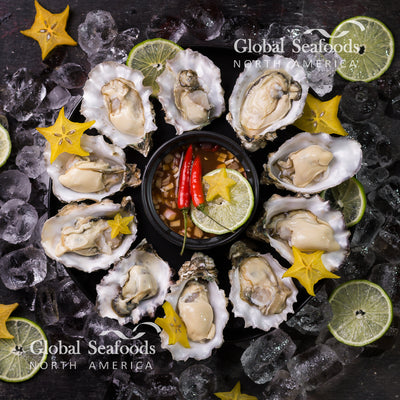Oyster Bar Etiquette: Essential Do's and Don'ts for a Great Dining Experience

Oyster Bar Etiquette – Dining
Dining at an oyster bar is more than just a meal; it’s an experience that blends sophistication with the rich flavors of fresh seafood. Whether you're a seasoned oyster lover or a first-timer, understanding oyster bar etiquette will enhance your enjoyment and help you make the most of this culinary delight. In this guide, we’ll dive deep into the world of oysters, covering etiquette, tips, pairings, and everything you need to know for an unforgettable dining experience.
Why Oyster Bars Are Special
Oyster bars are unique dining spaces where fresh seafood meets refined ambiance. They offer an array of oyster varieties sourced from different waters, each with distinct flavors influenced by their environment, or “merroir.”
Health Benefits of Oysters
- Rich in Nutrients: Packed with zinc, selenium, and vitamin B12.
- Low in Calories: Ideal for a light yet satisfying meal.
- High in Omega-3 Fatty Acids: Supports heart and brain health.
According to Seafood Watch, sustainably farmed oysters are also eco-friendly, playing a key role in maintaining marine ecosystems.
Oyster Bar Etiquette – Dos and Don’ts
Dining at an oyster bar is about appreciating the art of seafood. Here’s how to do it right:
Dos:
- Order Locally: Ask your server about local oyster varieties to enjoy the freshest options.
- Taste Before Adding Condiments: Slurp your first oyster plain to savor its natural flavors.
- Use the Proper Utensils: A small fork is provided for detaching the oyster from its shell.
- Pair Thoughtfully: Choose wines, beers, or spirits that complement the oysters.
- Dispose of Shells Correctly: Place empty shells face down on the plate.
Don’ts:
- Avoid Overdressing: Using too much sauce or lemon can mask the oyster's natural taste.
- Don’t Be Afraid to Ask Questions: Servers are happy to explain the menu or suggest pairings.
- Never Rush: Eating oysters is a slow and enjoyable process.
How to Taste Oysters Like a Pro
To truly appreciate oysters, focus on their flavor, texture, and aroma.
Step-by-Step Tasting Guide:
- Visual Inspection: Look for a clean, plump oyster with clear liquid.
- Smell: Fresh oysters should smell like the ocean, with no fishy odor.
- Slurp and Chew: Gently slurp the oyster and chew it a few times to release its flavors.
- Notice the Finish: Pay attention to the lingering taste, which varies by region and species.
Popular Oyster Varieties and Their Flavors
1. Miyagi Oysters
- Flavor: Sweet and buttery with a slight brininess.
-
Best Pairing: Crisp Sauvignon Blanc or dry sparkling wine.
Shop Miyagi Oysters
- Flavor: Mildly sweet with earthy undertones.
-
Best Pairing: Light lager or citrus-forward IPA.
Shop Willapa Bay Oysters
3. Maine Oysters
- Flavor: Salty and robust, with a clean finish.
-
Best Pairing: Chardonnay or gin-based cocktails.
Shop Maine Oysters
4. Tidepoint Oysters
- Flavor: Subtle sweetness with a creamy texture.
-
Best Pairing: Dry Riesling or Pale Ale.
Shop Tidepoint Oysters
Pairing Oysters with Beverages
Pairing oysters with the right drink can elevate their flavors.
Wines:
- Champagne or Prosecco: Complements the salinity with crisp acidity.
- Sauvignon Blanc: A classic pairing with citrus and herbal notes.
- Chablis: Offers a clean, mineral taste that mirrors the oyster’s merroir.
Beers:
- Stouts: Their creamy texture balances the brininess of oysters.
- Pilsners: Light and refreshing, perfect for delicate oysters.
Spirits:
- Gin: Enhances the salinity with herbal complexity.
- Vodka: Clean and neutral, allowing the oyster’s flavors to shine.
FAQs About Oyster Bars
Q: Do I need to tip at oyster bars?
A: Yes, tipping is customary, especially if you receive excellent service or shucking skills.
Q: What are the best condiments for oysters?
A: Classic mignonette sauce, freshly squeezed lemon, or a dash of hot sauce.
Q: Are all oysters safe to eat raw?
A: Only consume oysters from trusted sources like Global Seafoods to ensure freshness and safety.
Where to Buy Premium Oysters
Bring the oyster bar experience home with these premium options:
YouTube Channel Link:
For expert tips and recipes, visit the Global Seafoods YouTube Channel.
Conclusion
Dining at an oyster bar is a culinary experience that combines fresh flavors, refined ambiance, and the artistry of seafood. With the right etiquette and an understanding of oyster varieties, you can fully enjoy this sophisticated delicacy. From selecting premium oysters to pairing them with the perfect drink, each step enhances your journey into the world of oysters.
Order premium oysters from Global Seafoods and elevate your dining experience today!
Also in News

How to Make Sea Bream Sushi With Dry-Aged Tuna & Crab Roll — Step-by-Step With Chef Joshua
A complete guide to making Sea Bream sushi at home, including filleting, curing, slicing, and building a Dry-Aged Tuna & Crab sushi roll. Chef Joshua shares professional tips for restaurant-quality results.

Boiled Crab for Game Night: Everything You Need for a Perfect Seafood Party
Take your game night to the next level with a Boiled crab party. Learn the best recipes, cooking tips, and hosting hacks for a memorable seafood feast.

Boiled Crab for Date Night: A Romantic Guide to the Perfect Seafood Feast
Make your next date night unforgettable with a romantic Boiled crab experience. This guide covers everything you need to know, from ambiance to the best crab varieties.






